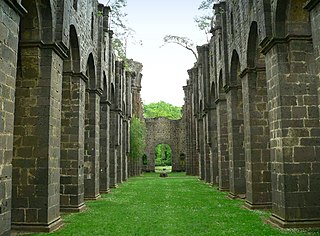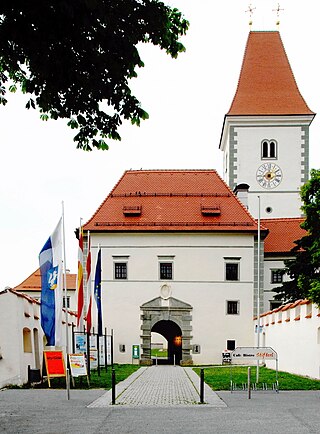
Spittal an der Drau is a town in the western part of the Austrian federal state of Carinthia. It is the administrative centre of Spittal an der Drau District, Austria's second largest district (Bezirk) by area.

Zwettl Abbey is a Cistercian monastery located in Zwettl in Lower Austria, in the Diocese of St. Pölten.

Seckau Abbey is a Benedictine monastery and Co-Cathedral in Seckau in Styria, Austria.

Hemma of Gurk, also called Emma of Gurk, was a noblewoman and founder of several churches and monasteries in the Duchy of Carinthia. Buried at Gurk Cathedral since 1174, she was beatified on 21 November 1287 and canonised on 5 January 1938 by Pope Pius XI. Her feast day is 27 June. Hemma is venerated as a saint by both the Catholic Church and the Eastern Orthodox Church, and as patroness of the current Austrian state of Carinthia.

Ossiach Abbey is a former Benedictine monastery in Ossiach, in the Austrian state of Carinthia. The site is one of the venues of an annual music festival called "Carinthian Summer".

Saint Paul's Abbey in Lavanttal is a Benedictine monastery established in 1091 near the present-day market town of Sankt Paul im Lavanttal in the Austrian state of Carinthia. The premises centered on the Romanesque monastery church were largely rebuilt in a Baroque style in the 17th century.

Seeon Abbey is a former Benedictine monastery in the municipality of Seeon-Seebruck in the rural district of Traunstein in Bavaria, Germany.

Millstatt am See is a market town of the Spittal an der Drau District in Carinthia, Austria. The traditional health resort and spa town on Lake Millstatt is known for former Benedictine Millstatt Abbey, founded about 1070.

Bad Kleinkirchheim is a municipality and spa town in the district of Spittal an der Drau, in Carinthia, Austria.
The Aribonids were a noble family of probably Bavarian origin who rose to preeminence in the Carolingian March of Pannonia and the later Margraviate of Austria in the late ninth and early tenth centuries. The dynasty is named after its ancestor Margrave Aribo of Austria. The Aribonids maintained influence in the Duchy of Bavaria, the Austrian march, and other parts of Germany until the early twelfth century, when they disappear.

Stams is a municipality in Imst District, in the Austrian state of Tyrol. It is chiefly known for Cistercian Stams Abbey, founded in 1273 by Count Meinhard II of Gorizia-Tyrol and his wife.

The Roman Catholic Diocese of Gurk-Klagenfurt is a Catholic diocese covering the Austrian state of Carinthia. It is part of the ecclesiastical province of Salzburg. Though named after Gurk Cathedral, the bishop's see since 1787 is in Klagenfurt.

Rein Abbey is a Cistercian monastery in Rein near Gratwein, Styria, in Austria. Also known as the "Cradle of Styria", it is the oldest surviving Cistercian community in the world.

Obermillstatt is a village and cadastral community in the municipality of Millstatt in Spittal an der Drau District, in Carinthia, Austria.

Niederfalkenstein Castle is a medieval castle near Obervellach in Carinthia, Austria. It is part of the larger Falkenstein fortification complex; while the main fortress of Oberfalkenstein today is a ruin, the lower barbican of Niederfalkenstein is largely preserved.

Arnsburg Abbey is a former Cistercian monastery near Lich in the Wetterau, Hesse, Germany. It was founded by monks from Eberbach Abbey in 1174. Although heavily damaged in the Thirty Years' War it was rebuilt later in the 17th century and prospered in the 18th century, when much of the abbey was rebuilt in Baroque style.

Domitian of Carantania or Domitian of Carinthia, also known as Domislav and Tuitianus, was a Slavic nobleman in the principality of Carantania during the reign of Charlemagne. He is regarded as the legendary founder of the Millstatt Abbey church and was venerated as a Catholic saint.

The former Augustinian "choral" Abbey of Eberndorf is located in a small bilingual market town half an hour to the east of Klagenfurt in Carinthia (Austria).

The Order of Saint George is an Austrian chivalric order founded by the Habsburg emperor Frederick III and Pope Paul II in 1469. Established as a military order to advocate the Christian faith, its original implicite goal was to combat the Ottoman incursions into the Inner Austrian lands of Styria, Carinthia and Carniola. The order resided at Millstatt Abbey and in Wiener Neustadt, until in 1598 its properties were handed over to the Jesuit college in Graz.
































